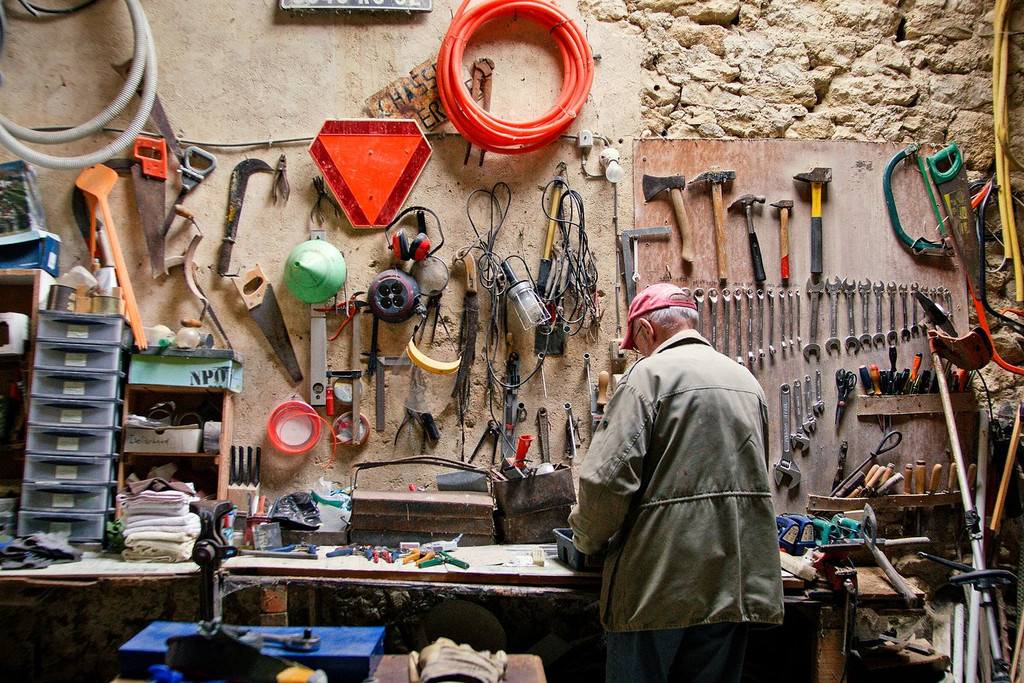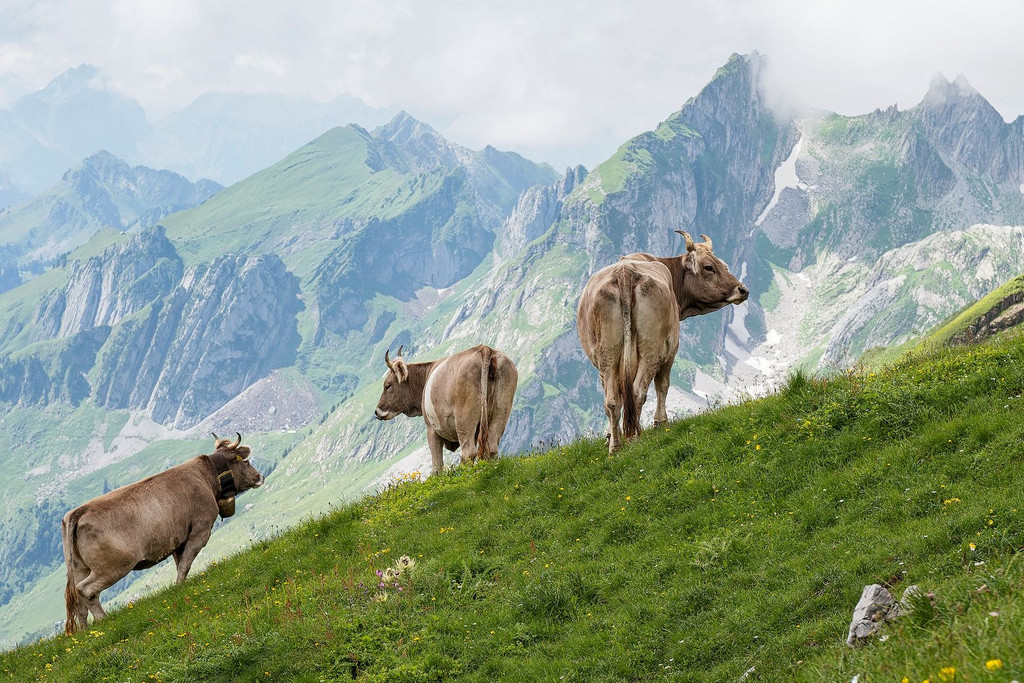A town with no river or lake, located at an altitude of 1,000 metres and reached by a train that owing to the gradient has to take a zigzag route to arrive at its destination: This is La Chaux-de-Fonds, home of the creative artists Jacques and Hubert Froidevaux, known as Plonk et Replonk. The name in itself is a gag, as the team actually has a third member – Miguel Morales, a childhood friend of the brothers.
“La Chaux-de-Fonds is a place people leave,” jokes Jacques, the elder brother, born in 1963, reeling off the names of famous figures who have departed the town: Blaise Cendrars, Le Corbusier and Jean Chevrolet. Why would anyone want to leave? Perhaps because of the climate... “Six months of winter and six months of taxes,” is Hubert’s summary. They have nevertheless remained “up on high”. The reason why will be explained later.
Gnomes in concrete
Plonk et Replonk take their raw material from clichés. In Switzerland, this inevitably means chocolate, watches, the Matterhorn and garden gnomes. For 15 years, the cheerful team of Plonk et Replonk has been plunging gnomes into cement. The basic model – a cube from which emerges only the gnome’s head down to just above the nose – weighs 8 kilos. There are also XL models weighing 20 kilos. One of the advantages of the garden gnomes encased in concrete like a nuclear fallout shelter is that “children cannot move them”, joke the comics, who are fans of Swiss humorists such as Zouc and Bernard de Haller, and also the impressionist Yann Lambiel and the comic Thierry Meury, among others.
Why on earth would you dip gnomes in cement? “To make them feel secure”, say the Froidevaux brothers, describing a broken-down Europe where poverty and inequality are on the rise while the fear of foreigners is increasing all around. “In Switzerland, we are being pulled back towards the years of the Schwarzenbach initiative,” grumbles Hubert. “Switzerland is not immune to social tension, but the impact is less pronounced here. People are not being forced to live on the streets,” concedes Jacques.
When they travel, to Paris for example, the two natives of La Chaux-de-Fonds, who are passionate about Africa, find all the clichés thrown back in their own faces. “The French tend to sum us up as banks and think the Swiss-French accent is unique, whereas there are actually at least 15 of them,” says Jacques through gritted teeth. The approval of the initiative against mass immigration on 9 February 2014 has not helped matters. “We’re keeping quite a low profile,” explains Hubert, who was mocked by Parisian friends at the “Baron Rouge”, a bistro where they have exhibited their work on three occasions.
300 pencil sharpener blades
Plonk et Replonk tried out various places in Switzerland, notably Lausanne – “where people are less inclined to talk to each other”, says Jacques – but ultimately it is La Chaux-de-Fonds that suits them best. “My barber is one minute away and my doctor 37 seconds. In short, life here is straightforward,” says Hubert. Another advantage is that here in watchmaking country our two artists can find all the craftsmen and women they need, in other words all the artisans offering the requisite level of quality. “I love precision,” says Jacques, who together with his brother has created the “pinaillette”, a kind of portable guillotine for splitting hairs. “The stationer freaked out a bit when we gave him an order for 300 pencil sharpener blades. I told him I had children who do a lot of colouring-in,” guffaws the elder brother.
Not far from their chaotic studio above “Le Pod”, the main street in La Chaux-de-Fonds, a metalworker is engraving numbered plaques for the “pinaillettes” and the garden gnomes. The local Migros is well stocked with gnomes, and cement is also readily available in the town. But Plonk et Replonk confess that for the last few years they have actually ordered their garden gnomes (made in Austria) by post. They estimate that to date they have purchased around a thousand.
The art of subverting postcards
The postcard plays a central role in the humorous work of Plonk et Replonk, and it was subverting these icons of the 19th and 20th centuries that earned them their first commissions in 1995. “Postcards show the banal, things that you no longer see,” says Jacques. Within this system, Geneva is summed up by its Jet d’Eau, Berne by its bears and Switzerland by the Matterhorn. The two acolytes have incorporated other clichés into their work: the family, patriotism, soldiers, obsolete occupations and monuments, the height of absurdity.
150 years ago, postcards served as a form of media, point out the two knowledgeable artists, displaying examples of news stories with images of flooding, cyclones and aviation accidents. This dose of verité was enhanced by the quality of the images of the day. “People posed for a long time in front of the camera, and when someone looks at the lens you feel their presence, because the sensitive plates were large and the photos were consequently of an extraordinary quality,” reveals Hubert, pointing to a dreadful postcard in which British colonists in Hong Kong are posing in front of the decapitated heads of indigenous inhabitants laid out on the ground (we later discover that they have Father Christmas hats). Finally, the cards’ sepia tone gives them an antique (and thus authentic) patina. All that remains is to add some pseudo-serious captions which, when combined with images that are photoshopped to a greater or lesser degree, create a hiatus. This is the effect the Swiss duo aim to achieve.
Complaint to the tourism office
In La Chaux-de-Fonds, one of Plonk et Replonk’s bogus postcards depicts the explosion of a water pipe (a historical event) in the town’s streets. “Two old ladies commented on the image and tried to recall the event, whereas what you are actually looking at is a picture of Niagara Falls,” laughs Hubert. In a similar vein, a postcard showing barges on a canal running right down the middle of Le Pod – the main street in La Chaux-de-Fonds – is said to have baffled some Belgian tourists. “They complained to the tourism office about the absence of the canal,” recalls Hubert, adding that the same office asked them to be included in a cultural tour of the town that would have given Plonk et Replonk cult status – a request that really took the biscuit for these disparagers of monuments.
The high point of their already hugely eventful career perhaps came in 2010 at the Colombier military museum, during an exhibition entitled “Military extravaganza 1515 to 2015: five centuries of heroic resistance”, one of the highlights of which was a castle built by Jacques out of military biscuits. The event brought together members of the Swiss political and military establishment, including the former socialist cantonal councillor Jean Studer (currently President of the Bank Council at the Swiss National Bank) and also André Duvillard, who was then chief of the Neuchâtel police service and is now the delegate of the Swiss Security Union. “The high-ranking officials certainly spluttered a little during the inauguration,” says Hubert, but Duvillard said that the army’s scope for progress depends on its ability to mock itself “which indicates that the army is less rigid than it seems”, echoes Jacques Froidevaux. Last but not least, the postcard images are old and therefore out of copyright. In a town without a permanent water supply, it’s all about being economical with one’s resources!
stéphane herzog is an editor with the “swiss review”
A Swiss childhood
Biscuits, the army and watches – all touched upon and lampooned by Plonk et Replonk from Noirmont, a small watchmaking town in the Franches-Montagnes where Jacques and Hubert Froidevaux and their friend Miguel Morales grew up. “At the time, the army had an enormous budget. We used to chase the soldiers to ask them for biscuits and chocolate,” recalls Hubert. While they were growing up the boys spent a lot of time at a café-restaurant run by their mother. The bistro brought all of Noirmont together, from workers to the factory owner. Their father was a carpenter. For a time he also made coffins, as was the custom back then. But not for long. “One day, when his VW camper was full, my dad put a coffin on the roof and drove through Saignelégier like that with a cigar in his mouth,” recounts Hubert. “The workers at the Ciny watchmaking factory, who were sanctimonious, saw him going past and complained to the priest.” That was the end of the mortuary concession for Froidevaux senior. And perhaps the beginning of the career of Plonk et Replonk, with a first fanzine edited by Jacques and Miguel called “Yaourt vert” (Green yoghurt), which later became “Yaourt qui tue” (Killer yoghurt). Quite some undertaking.



















Comments
Comments :
Merci Plonk et Replonk vous êtes ce beau côté de l'humour suisse qui s'amuse à rire de nous-mêmes!
J'ai moi aussi grandi dans un petit bistrot jurassien et je vois "une enfance suisse" avec vos mêmes yeux!
C'est le fun de vous lire!
"L'humour" suisse ne s'exporte pas car il n'a pas la qualité de ses montres ou de son chocolat. Dommage...
Are the books available in the UK?